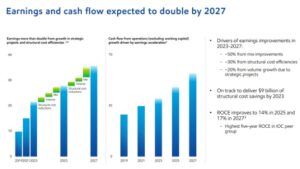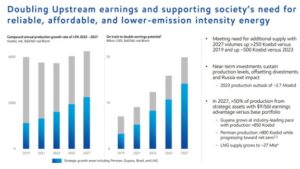First Published on January 31st, 2023 by Aristofanis Papadatos for SureDividend
Long histories of dividend growth are not typical in the energy sector. The oil and gas industry is highly cyclical, preventing the vast majority of companies from raising their dividends yearly without interruption. When oil and gas prices are high, energy companies enjoy a windfall that flows through to investors. But when commodity prices decline, profits evaporate, and in some cases, dividends as well.
As a result, there are just two oil stocks on the list of Dividend Aristocrats. One of them, Exxon Mobil (XOM), is the largest oil company in the U.S.
You can download the full list of all 68 Dividend Aristocrats, with important metrics like dividend yield and price-to-earnings ratios, by clicking on the link below:

Oil and gas can be a “boom-and-bust” industry. Profits are highly dependent upon commodity prices, which can fluctuate wildly in any given year depending upon supply and demand forces.
But Exxon Mobil is different. It traces its roots to Standard Oil, which was founded by John D. Rockefeller all the way back in 1870.
This article will provide an in-depth look at the founder of Big Oil and a Dividend Aristocrat, Exxon Mobil.
Business Overview
Standard Oil dominated the U.S. oil and gas industry in its early days. It did this with a laser-like focus on drilling innovation, production growth, and limiting costs to beat its competitors. Standard Oil was almost too successful—it grew rapidly that in 1911, it was dissolved by the U.S. Supreme Court on antitrust grounds.
Standard Oil was broken up into 33 smaller companies, many of which became giants on their own, such as Chevron (CVX).
Exxon Mobil operates in three business segments. The Upstream segment includes oil and gas exploration and production. Downstream activities include refining and marketing. Manufactured chemicals include olefins, aromatics, polyethylene, and polypropylene plastics.
Exxon Mobil is one of the largest energy stocks in the world. 2020 was an especially rough year for Exxon Mobil and the entire energy sector due to the coronavirus pandemic, which negatively impacted the global economy and oil prices. However, thanks to the massive distribution of vaccines worldwide, global oil consumption began to recover in 2021.
In addition, oil producers have greatly benefited from the invasion of Russia in Ukraine and the resultant Western countries’ sanctions on Russia. Before the sanctions, Russia produced approximately 10% of global oil output and one-third of natural gas consumed in Europe. Due to the sanctions, the global oil and gas markets became exceptionally tight last year, and thus the prices of oil and gas rallied to 13-year highs.
The merits of the sky-high oil and gas prices were clearly reflected in the results of Exxon Mobil. The oil giant more than doubled its earnings per share, from $5.38 in 2021 to $14.06 in 2022.
The prices of oil and gas have incurred a correction off their peak, but they remain elevated. As a result, Exxon Mobil could still achieve earnings per share of about $10.50 this year. This level is lower than the record level achieved last year but will mark the company’s second-best performance if it materializes.
Growth Prospects
The climate for oil and gas majors remains challenged because oil prices are still down by nearly half from the peak levels of 2014. As a result, oil producers cannot rely on rising prices for revenue and earnings growth. Instead, rising production will be key. Thanks to its promising growth projects, Exxon expects to grow its production from about 4.0 to 5.0 million barrels per day by 2025.
The Permian will be a major growth driver, as the oil giant has about 10 billion barrels of oil equivalent in the area and expects to reach production of more than 700,000 barrels per day in the area by 2025. In the 2021 fourth quarter, production in the Permian increased by nearly 100,000 oil-equivalent barrels per day, with improved capital efficiency.

Source: Investor Presentation
Exxon Mobil expects to achieve such a great performance primarily thanks to a steep reduction in its average cost of production, which will result from the addition of low-cost barrels in its asset portfolio. The other growth contributors will be a reduction in structural costs as well as meaningful production growth.
Guyana, one of the most exciting growth projects in the energy sector, will be a major growth driver of Exxon. During the last five years, Exxon Mobil has more than tripled its estimated reserves in the area, from 3.2 billion barrels to about 11.0 billion barrels.
Notably, about 90% of the investments of Exxon Mobil will be directed to reserves that are expected to yield an annual return in excess of 10% even at oil prices of around $35. This means that the oil giant will high-grade its asset portfolio drastically in the upcoming years.
Thanks to its promising growth plan, Exxon Mobil expects to grow its production by 3% per year on average until 2027 and double its earnings potential at a given price of oil of $60.

Source: Investor Presentation
In this way, the oil major will offset the effect of the exit of its operations from Russia and some other divestments. In addition, more than half of its output will come from reserves with an advantage of $9 per barrel vs. its current asset portfolio.
The growth plan of Exxon Mobil also includes a share repurchase program of up to $35 billion in 2023-2024. This amount is sufficient at the current stock price to reduce the share count by 7%. However, we are concerned over the value of share repurchases at an all-time high stock price, near the cycle’s peak. Given the high cyclicality of the oil industry, the share repurchases executed around all-time high stock prices are likely to impair shareholder value instead of enhancing it.
Despite the doubtful prospects of the share repurchase program of Exxon Mobil, its growth plan is certainly on the right direction and promising. Nevertheless, given the high cyclicality of this business, it is reasonable to expect a -9% average annual decline of earnings per share over the next five years off this year’s high comparison base, especially given the record number of clean energy projects that are in their development phase right now.
Competitive Advantages & Recession Performance
Exxon Mobil enjoys several competitive advantages, primarily its tremendous scale, which provides the ability to cut costs when times are tough. The company is also the global leader in expertise in its business, as most oil companies follow the technical procedures that Exxon Mobil has written. It is also remarkable that other oil companies drilled about 40 dry holes offshore in Guyana, whereas Exxon Mobil has a ~90% success rate in the area.
Exxon Mobil also has the financial strength to invest heavily in new growth opportunities. The company has allocated tens of billions of dollars in the past few years on capital expenditures to support future growth.
Another competitive advantage is Exxon Mobil’s industry-leading balance sheet. It has a credit rating of AA-, which helps it keep a low cost of capital.
Exxon Mobil’s integrated business model allows the company to remain profitable, even during recessions and periods of low commodity prices. The company saw volatility during the Great Recession but still remained profitable:
- •2007 earnings-per-share of $7.26
- •2008 earnings-per-share of $8.66 (19% increase)
- •2009 earnings-per-share of $3.98 (54% decline)
- •2010 earnings-per-share of $6.22 (56% increase)
Continuing to generate steady profits allowed Exxon Mobil to raise its dividend yearly. The oil major has raised its dividend for 40 consecutive years and is expected to announce its next dividend raise in April.
Valuation & Expected Returns
Exxon’s industry is highly cyclical. Commodity prices drive results, and hence they are highly volatile. We believe that the energy market is now near the peak of its cycle and expect oil and gas prices to deflate in the upcoming years, primarily due to the record number of clean energy projects that are under development right now. We expect Exxon Mobil to earn about $10.50 per share in 2023 and incur a -9% average annual decline of earnings per share over the next five years.
The stock is currently trading at a price-to-earnings ratio of 10.9. This is lower than our fair value estimate of 13 times earnings. A higher earnings multiple could boost annual returns by 3.7% over the next five years.
Dividends will add to shareholder returns. Exxon Mobil has grown its dividend for 40 consecutive years and currently offers a 3.2% yield. Given all the above factors, Exxon Mobil can be reasonably expected to offer a -1.8% average annual total return over the next five years.
The poor expected return should be expected, given that we are near the peak of the cycle of this highly cyclical industry. We recommend selling Exxon at its current price. The 9-year low dividend yield of the stock is just another signal that the stock is overvalued from a long-term perspective.
Final Thoughts
Exxon Mobil posted record earnings last year thanks to exceptionally favorable global oil and gas conditions. Even better, as these conditions are not likely to change significantly soon, the oil major is expected to continue thriving in the upcoming quarters. Nevertheless, due to the high cyclicality of this industry, the stock is unattractive from a long-term perspective.
This article was first published by Aristofanis Papadatos for Sure Dividend
Sure dividend helps individual investors build high-quality dividend growth portfolios for the long run. The goal is financial freedom through an investment portfolio that pays rising dividend income over time. To this end, Sure Dividend provides a great deal of free information.
Related:




